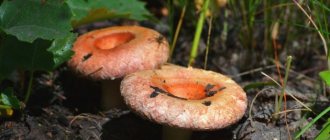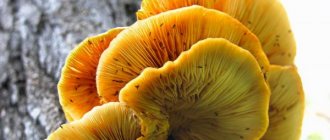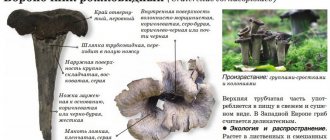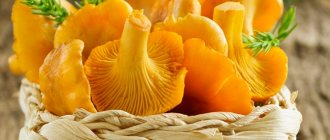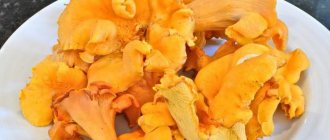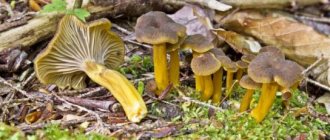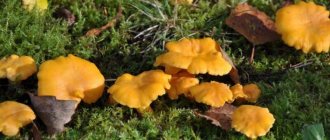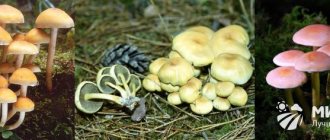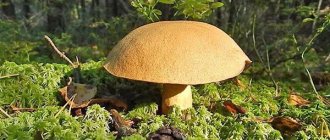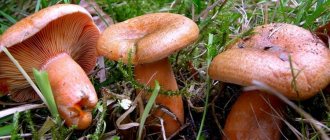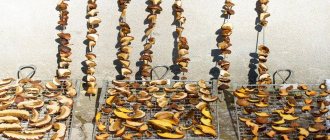Good afternoon, many will be interested in understanding their health and loved ones, and I will tell you my experience, and we will talk about false and real chanterelles: similarities and differences. Most likely, some details may differ, as was the case with you. Please note that you should always consult with highly specialized specialists and not self-medicate. Naturally, you can quickly find the answer to the simplest questions and diagnose yourself. Write your questions/suggestions in the comments, and together we will improve and supplement the quality of the material provided.
Chanterelles are popular forest mushrooms that are famous for their unique taste, aroma and ability to saturate the human body with nutrients and vitamins. However, often, along with real mushrooms, mushroom pickers’ baskets include their false counterparts, which do not have beneficial qualities and can cause harm to health. How to distinguish false chanterelles from real ones and thereby avoid sad consequences?
Characteristic differences between false chanterelles and real ones
A characteristic difference between real chanterelles and false ones is that the former never grow as single specimens. Having found one edible mushroom in the forest, you should look around and look under the fallen leaves. Most likely, you will find a whole family of chanterelles there.
Before understanding the differences between false and real chanterelles, you should determine the potential danger of inedible species. Often mushroom pickers throw away the entire forest harvest just because several false chanterelles have ended up in their basket. However, many experts do not believe that they cause serious damage to the human body. Although false chanterelles are worse in taste than real ones, and their smell is not very pleasant, they are still classified as conditionally edible mushrooms, but not poisonous. The worst thing that can happen when consuming these fruiting bodies is a slight intestinal upset.
Many lovers of “quiet” hunting compare false and real chanterelles with red fox tails, as if sticking out of holes. The caps and legs of edible chanterelles are always one whole. The plates smoothly descend towards the middle of the stem, and almost the entire mushroom has the same color. The hue of false chanterelles is brighter, and the leg is noticeably thinner.
However, the most important difference between real and false chanterelle mushrooms is the absence of signs of worminess in the former. This is due to the presence of chitinmannose in the pulp - a substance that does not allow foreign “tenants” to live in the body of the mushroom and eat it. Inedible species of chanterelles are readily eaten by insects and worms.
We invite you to look at several photos of real and false chanterelles to see their similarities and main differences:
What to do if poisoning occurs
For people with a sensitive gastrointestinal tract, eating false chanterelles can result in food poisoning of varying severity - it all depends on the amount of mushrooms eaten. Its main symptoms are stomach upset, nausea, vomiting; in severe cases, the temperature may rise, chills, dizziness, and loss of consciousness may appear. In any case, if such symptoms appear after a meal with mushrooms, the first aid will be gastric lavage. It is necessary to constantly drink warm boiled water in large quantities, inducing vomiting until the stomach is cleared. Of course, all this should happen after an ambulance is called, because mushroom poisoning is severe and can cause significant harm to human health.
False chanterelles are mushrooms that were categorically forbidden to be eaten for a long time, considering them dangerous. Today they are classified as more or less edible products, but in order to be able to prepare dishes for the table from false chanterelles, you will have to tinker with them - soak and boil until the mushrooms become suitable for food. Each lover of mushrooms and dishes made from them decides for himself whether the effort expended is worth the resulting result. Usually, the taste of the mushrooms themselves is not very impressive to chefs, but they are used to prepare julienne, pies, sauces and pickles for the winter.
How to distinguish false chanterelles from real ones by external signs
You can distinguish false chanterelles from real ones by the following external signs:
- The caps of edible chanterelles have wavy edges, while those of false representatives have regular and even edges.
- Real mushrooms have a pleasant fruity smell, reminiscent of a peach or apricot, while false mushrooms have a rotten smell.
- Good chanterelles always grow in large groups, false ones - in single specimens.
- Original chanterelles usually grow in damp moss, grass or litter, preferring pine trees, birch, oak and beech; false ones grow on fallen, rotting trunks and branches.
- When pressed, the flesh of the edible chanterelle changes color and becomes red; the false chanterelle never changes its color.
- The surface of the cap of a real chanterelle is smooth and matte; the skin is difficult to separate from the pulp. In false chanterelles, the skin is easily removed, and the surface of the cap has some roughness.
- The legs of a real chanterelle are thick and do not have a void inside; the false type of mushroom grows with a thin, hollow stalk.
A common feature between true and false chanterelles is the fact that they grow in the same mixed or coniferous forests, preferring a temperate climate. In addition, the collection of edible chanterelles occurs in the months of August-October, precisely the time when false ones also grow.
The photos below will help you identify real and false chanterelle mushrooms. They will be especially interesting for beginners who like “silent hunting”. Knowing these differences, each of them will be able to collect only edible and safe chanterelles in their baskets.
Many lovers of “quiet” hunting compare false and real chanterelles with red fox tails, as if sticking out of holes. The caps and legs of edible chanterelles are always one whole. The plates smoothly descend towards the middle of the stem, and almost the entire mushroom has the same color. The hue of false chanterelles is brighter, and the leg is noticeably thinner.
Red or orange mushrooms that look like chanterelles
The main counterparts are the yellow hedgehog and the orange talker. It is these species that are most often confused with chanterelles.
Yellow hedgehog
This species is a representative of the genus Gidnum of the Hedgehog family. This is an edible mushroom. Many people put its taste on par with the taste of chanterelle pulp. In mycological reference books, this species is described as Ezhovik notched, as well as Hydnum and Dentium notched.
The hedgehog is of medium size. The diameter of its cap varies from 6 to 12 cm. The height of the stem reaches 6 cm, and its cross section is 2.5 cm.
You may be interested in: How do edible talkers differ from false mushrooms? How many days after rain do mushrooms grow? Bitter mushroom: photo and detailed description
The hat has a flattened shape. Its edges are always turned inward. Very often there are specimens with an irregular, asymmetrical cap. And most fruits within the same mycelium grow together. The surface of the cap is smooth. Its color is usually yellowish. But you can find hedgehogs with both white-yellow and orange caps.
The leg is cylindrical in shape with a slight expansion at the base. Inside it is solid, without voids. Very often there are mushrooms with small potholes on the surface. The color of the stem is always slightly paler than the cap.
The hymenophore is represented by small pointed spines located on the inside of the mushroom cap. The spines repeat the color of the leg. With light pressure they fall off. Spore powder is white.
The pulp is thick and has a whitish tint. It has a fairly dense structure. The pulp of the yellow variety of hedgehog exudes a faint, pleasant aroma.
Mushrooms can be found in deciduous and coniferous forests, as well as in mixed plantings.
Mycelium grows in large groups, preferably in moss. Peak fruiting occurs in August. But in general, you can start looking for hedgehogs in July. The last mushrooms are found in October.
Types of chanterelles photo and description
Most species of chanterelles are edible. There are more than 60 species of chanterelles; none are poisonous, but there are inedible species - the false chanterelle, for example.
We recommend reading: Increase in cholesterol from femoston
Common chanterelle
- edible mushroom. The cap is 2-12 cm in diameter. Mushrooms with fleshy flesh, yellow on the edges and white on the cut. Common chanterelle tastes sour. Grows in coniferous and deciduous forests from June to October.
Gray chanterelle
- edible mushroom. The color of the chanterelle is from gray to brown-black. The cap is up to 6 cm in diameter, with wavy edges and a depression in the center, the edges are ash-gray.
The elastic pulp is gray in color, with an inexpressive taste and no aroma.
The gray fox grows in deciduous forests from June to October. This species is little known to mushroom pickers; they avoid it.
Cinnabar red chanterelle
- edible mushroom. The color of the chanterelle is reddish or pinkish-red. The cap is up to 4 cm in diameter, the leg is up to 4 cm high. The flesh is fleshy with fibers. The cap is concave towards the center with uneven curved edges. The vermilion chanterelle can be found in oak groves in eastern North America. Mushroom picking occurs in summer and autumn.
Velvety Chanterelle
- a rare, edible mushroom. The cap is orange-yellow or reddish, up to 5 cm in diameter, convex in shape, eventually becoming funnel-shaped. The pulp is light orange with a pleasant smell. Velvety chanterelle grows in deciduous forests of eastern and southern Europe on acidic soils. This mushroom is collected from July to October.
Chanterelle yellowing
- edible mushroom. The cap is up to 6 cm in diameter, yellowish-brown in color, covered with scales. The cut flesh is beige, tasteless and odorless. Can be found in coniferous forests, on moist soils during the summer.
Trumpet chanterelle
- edible mushroom. The cap is up to 8 cm in diameter, funnel-shaped with uneven edges, grayish-yellow in color. The pulp is dense, white when cut, has a pleasant earthy smell and has a bitter taste. Mainly grows in coniferous forests.
Chanterelle Cantharellus minor
– similar to the common chanterelle, an edible mushroom. The cap is up to 3 cm in diameter, orange-yellow in color, with wavy edges. The pulp is soft, brittle, yellow. This chanterelle grows in the oak forests of North America.
Where do orange talkers grow?
Common and false chanterelles grow in different places in the forest. However, they prefer coniferous and mixed plantings, high humidity and warm conditions. The common chanterelle forms mycorrhiza with various trees - pine, spruce, beech, oak. The main ripening period is in early June, then from August to mid-autumn.
The orange talker is found on the forest floor. She does not require symbiosis with trees. False chanterelle grows in deciduous and coniferous areas. The food source is rotting wood and leaves. Often the yellow forest beauty is found in moss or near anthills. Mushrooms are collected in temperate climates of Europe and Asia.
The orange talker mushroom actively develops after rains. Increasing humidity and temperature creates favorable conditions for growth. Fruiting bodies are found near streams, lakes, and rivers. During drought and after frost, the likelihood of encountering a false chanterelle is lower.
False chanterelle grows singly or in large groups. The mycelium bears fruit annually. Ripening begins in August and lasts until November. Most mushrooms are found in mid-August and September.
Chanterelles - description and photo
Golden-colored mushrooms have a delicate fruity smell, slightly reminiscent of apricot.
They are common in Europe, Russia, Africa, Mexico, and the Himalayas.
Hat and leg
The chanterelle looks solid, without visible boundaries, approximately the same color from pale yellow to orange.
The diameter of the cap is 5-12 cm, irregular in shape with wavy edges, funnel-shaped or concave, smooth with hard-to-remove skin.
The pulp is dense
and fleshy, white or yellowish in color with a faint odor of fruit and a slightly pungent taste. The surface of the chanterelle becomes reddish when pressed.
Chanterelle leg
dense, with a smooth structure, tapered at the bottom, up to 3 cm thick and up to 7 cm long.
Surface of the hymenophore
represented by wavy folds falling along the stem.
Spore powder
yellow color.
Description of false chanterelles
A species of mushroom called “false chanterelle” does not exist in nature. The term "false" is applied to similar species of fungi in relation to a specific member of the fungal kingdom.
On a note! The term “false chanterelles” refers to specific mushroom species that have pronounced similarities to chanterelles.
The most common name for the false fox is the orange talker. But in some regions this definition also applies to other forest species, such as the yellow bramble. Chanterelles can also be confused with some representatives of the genus of poisonous mushrooms Omphalotes, of the Negniumaceae family. But most often in mycological reference books only talker and hedgehog are listed as doubles of red mushrooms.
Doubles can reach different sizes, both small and medium. The diameter of their caps varies from 2 to 12 cm, the height of the legs - from 3 to 6 cm. The fruiting bodies are presented in a classic shape, with clear outlines of the cap, stalk, and hymenophore.
The shape of the hats is varied:
- convex;
- flat;
- flat-prostrate;
- depressed-funnel-shaped.
There are even representatives with irregularly shaped hats.
How to freeze chanterelles for the winter?
Clean the mushrooms from dirt, rinse and dry on a towel. You can freeze fresh, boiled, fried chanterelles.
When eaten raw after freezing, mushrooms may taste bitter.
Place the prepared mushrooms in bags or food containers and close tightly. Store in the freezer for 1 year at a temperature of -18 degrees.
You need to defrost the chanterelles in the refrigerator on the bottom shelf, at a temperature of +4 degrees. Thawed mushrooms cannot be re-frozen.
and orange talker (inedible mushroom)
How to cook black chanterelles
Various dishes can be prepared from the funnelwort, for example, the famous Leningrad solyanka. Before this, you need to remove the stem of the mushroom, rinse the cap well and clean it of adhering debris (grass, twigs and leaves). You can soak the product in water for several hours to completely remove all the dust from it.
Important! In their whole form, dried mushrooms retain their aroma longer, so it is recommended to grind them into powder immediately before preparing the dish.
Basic methods for preparing black chanterelles:
- to prepare mushroom pies and salads, pour the funnel with water, bring to a boil on the stove, and then cook for 10–15 minutes over medium heat;
- so that chanterelles can be added to other dishes or frozen in the freezer for the winter, it is necessary to cut the product into small pieces and fry it in oil with the addition of spices and seasonings for 5 minutes;
- black chanterelles can be dried - to do this, spread them in a thin layer on a baking sheet and place in an oven preheated to 100 ° C for 3 hours;
- To prepare the aromatic seasoning, dried mushrooms are ground into powder and then added to sauces, soups and main dishes.
Risotto is a traditional dish of Italian cuisine. Most often it is prepared with porcini mushrooms, but you can also prepare risotto with chanterelles. Very tasty, satisfying and aromatic
Despite its dark color, which is unusual for edible mushrooms, the funnel fungus can be used for preparing various dishes, as well as for the prevention of many diseases. Having studied the information presented above, you can easily distinguish this mushroom from other varieties of the Chanterelle family and learn how to properly use it in cooking.
Are false chanterelles poisonous?
Before we figure out how to distinguish false chanterelles from real ones, let's determine their potential danger. Many shy away from false representatives of the tribe, often throwing away edible specimens for fear of severe mushroom poisoning. Meanwhile, most mushroom pickers do not believe that false chanterelles can cause serious harm to the body. Their taste is much worse, the smell has become significantly worse, but false chanterelles are still classified as conditionally edible mushrooms rather than poisonous ones. The maximum risk is intestinal upset if your stomach is not too strong. However, the question of how to distinguish between false chanterelles and real ones is a concern for a huge number of novice mushroom pickers who do not go to the forest too often. Just to reassure them, we will list all the signs, although we assure you: if a disguised fungus wanders into your prey, it will not pose a mortal danger.
Time and place of collecting chanterelles
Chanterelles appear already in June. They grow massively from mid-July until autumn. If the weather permits, then until November. There are especially many of them in damp summers. It has been noticed that chanterelles are less likely than other mushrooms to undergo cyclicity. They do not have such pronounced growth waves as many other mushrooms. They say that many new chanterelles grow after thunderstorms.
Chanterelles are most often found in forests (coniferous and deciduous); they are also found on swamp hummocks. Chanterelles especially love mossy areas without tall grass.
Chanterelles are one of the most sociable mushrooms. They often grow (more precisely, pour out) in large groups. Many mushroom pickers know that a solitary growing chanterelle almost always indicates that you need to look for others nearby.
Miracle of nature: chanterelle mushroom
Chanterelles, false and real, got their name primarily due to their color, which, indeed, primarily evokes clear associations with a fairy-tale animal (in reality, foxes do not have such a bright coat). To many, mushrooms resemble fox tails sticking out of holes. These mushrooms themselves are large; the cap can reach a diameter of a dozen centimeters. At the same time, it represents a common whole with the leg, smoothly transitioning into it and differing little from it in color. The general shape that false and real chanterelles have is very interesting - the leg tapers downwards, forming an elegant, easily recognizable outline.
We recommend reading: A one-year-old child’s eye is red and a film has formed
Differences between the original and the fake
In addition to the worms' aversion to definitely edible mushrooms, there are other signs that signal danger. So, how to distinguish false chanterelles from real ones?
- Fakes are usually more brightly colored than mushrooms that do not require camouflage.
- A real chanterelle has wavy edges. The evenness of the cap should alert you.
- The “correct” mushroom smells like fruit or fresh wood. The false one has a distinctly unpleasant aroma.
- Real chanterelles never grow alone. False ones can and do love.
- The originals grow in moss; the fakes prefer rotting, fallen trunks.
- If you press the flesh of a real chanterelle, it will turn red. False color will not change.
Although the main argument of falsity is still the movement of the worm through the body of the chanterelle: it definitely says that it is not real.
How to collect chanterelles (false and real), what are the differences, how to cut without damage
Hunting for mushrooms – any kind! – implies knowledge of tricks, mushroom places and search secrets. Chanterelles - false and real - tend to hide their bodies in pine needles or, less commonly, in fallen leaves. However, if you notice at least one red tail, you can be sure that you have come across an entire plantation. Most often they settle in moss. It is enough to lift its layer - and here you have a whole basket of harvest. When the weather has not been pleasant with rain for a long time, you need to look for chanterelles in damp places, in grassy lowlands. But if there was a lot of precipitation, they move to higher ground or well-warmed clearings. In any case, trees growing nearby can serve as reference points, since chanterelles huddle close to oaks, birches, beeches, pines and spruces.
The signal for the beginning of the fox season can be the abundant flowering of wild raspberries. And if before it began there were thunderstorms with downpours, then there is no doubt about the success of the “silent hunt”. If there are no such obvious signs, exploration should begin from the end of June.
Unlike most forest mushrooms, chanterelles require a special approach when collecting. Under no circumstances should they be cut, much less plucked: this damages and, over time, kills the mycelium, resulting in the disappearance of the existing plantation. If you unscrewed the mushroom, then next year you can confidently come to the same place for new prey.
People who are far from “quiet hunting”, who have formed an opinion about it from books, movies and stories, believe that the best prey on it is boletus. However, an experienced mushroom picker will not always agree with this point of view. For many, chanterelles are more desirable. False and real are, without a doubt, a problem, but the porcini mushroom also has a dangerous double. But the taste of chanterelles and the lack of need for boiling put them in first place in the mushroom rating.
In addition to the worms' aversion to definitely edible mushrooms, there are other signs that signal danger. So, how to distinguish false chanterelles from real ones?
False chanterelle
(Hygrophoropsis aurantiaca) is no longer a poisonous mushroom.
Another name for the mushroom: cocosh. Despite the similarity with the real chanterelle, with which this mushroom is often confused, these mushrooms are not related. There is only external resemblance. Previously, all experts classified this mushroom as poisonous, without even mentioning the false chanterelle when they wrote about edible mushrooms allowed by GOST for harvesting. In many modern reference books, especially foreign ones, the false chanterelle
is classified as edible, but of lower quality than the common chanterelle. False chanterelles are considered conditionally edible. However, this mushroom is not particularly tasty. If they are prepared correctly, poisoning can be avoided. But if there is a weak digestive system, a person may feel unwell. For this reason, collecting them is not recommended. Due to the presence of poisonous toxins, this mushroom is still poisonous.
Description False chanterelles can be easily distinguished from real ones. False ones have caps that are brighter in color. Typically the color of the cap ranges from orange to orange-brown with a copper tint. In addition, in adult mushrooms the hat resembles a funnel in shape, while in a young mushroom it is slightly convex. The edges of the cap are smooth and even, the size of the cap is no more than 3-6 cm in diameter. The color of the cap is lighter at the edges than in the center. The surface is slightly velvety. The plates of the false one are more private and thinner than those of the real one. They are orange, branching, descending onto the stem, but not turning into it. You should also pay attention to the stem of the mushroom, since the false ones have a much thinner stem. It does not taper downward and is cylindrical in shape. Its color is orange-reddish; if you cut an adult mushroom, it is hollow. The color is darker at the bottom. The pulp of the false chanterelle does not have a pleasant aroma. The back of the cap tastes bitter. The false chanterelle has yellow or orange flesh. If you press with your finger, the color will not change. The spores of false chanterelles are white. In addition, false chanterelles can be worm-prone, which is not observed in real ones.
Poisonous or not? These mushrooms can be eaten, but they should be soaked for three days, replacing the water in the morning and evening. Then they are boiled for 15 minutes in boiling water. They can then be marinated or fried. But usually experienced mushroom pickers don’t even pay attention to them, since you can always find healthier and tastier mushrooms in the forest. It should also be remembered that in some people who are highly sensitive, eating false chanterelle can cause digestive problems. If handled incorrectly, if it gets into the stomach, the following symptoms appear: weakness, nausea, dizziness, diarrhea, vomiting, abdominal pain, cramps. It is necessary to immediately call an ambulance, in this case the patient will quickly recover. It should be remembered that if you feel even the slightest discomfort, you must immediately call an ambulance, as preserving your health and life depends on this!
We recommend reading: Intravenous urography of the kidneys: what it shows, preparation, how it’s done
Habitat This mushroom can often be found next to the real chanterelle. Prefers deciduous, mixed and coniferous forests. From July to October the mushroom bears fruit. Almost never seen alone. Mushrooms grow on rotting old trees, in moss, and on the forest floor. They are most numerous in late summer and autumn. It should be remembered that false chanterelles are most often found on fallen trees. So, if you are collecting mushrooms and see orange mushrooms on a fallen tree, you should not immediately collect them, since real chanterelles prefer mossy stumps.
False chanterelle
(Hygrophoropsis aurantiaca) is no longer a poisonous mushroom.
Another name for the mushroom: cocosh. Despite the similarity with the real chanterelle, with which this mushroom is often confused, these mushrooms are not related. There is only external resemblance. Previously, all experts classified this mushroom as poisonous, without even mentioning the false chanterelle when they wrote about edible mushrooms allowed by GOST for harvesting. In many modern reference books, especially foreign ones, the false chanterelle
is classified as edible, but of lower quality than the common chanterelle. False chanterelles are considered conditionally edible. However, this mushroom is not particularly tasty. If they are prepared correctly, poisoning can be avoided. But if there is a weak digestive system, a person may feel unwell. For this reason, collecting them is not recommended. Due to the presence of poisonous toxins, this mushroom is still poisonous.
Pulp
It has an orange-yellow color, it is thicker in the center and noticeably thinner towards the edges. The flesh of the leg is reddish. As it ripens, it begins to resemble cotton wool in consistency. It smells faintly (of mushrooms), there is practically no taste.
How to distinguish from similar species
There are several varieties of mushrooms that look like black chanterelle (the similarities can be seen in the photo).
But at the same time, they have a number of characteristics that allow them to be distinguished from the funnel funnel-shaped:
- urnula goblet - its black cap in shape also resembles a very deep funnel, but it is denser and more rigid in structure, and also does not have a turned-up edge and is unsuitable for food;
- convoluted funnel - has a cap of a similar shape, but with more dissected edges, and the mushroom itself is colored yellowish;
- gray chanterelle - also dark-colored, but unlike the funnel-shaped funnel-shaped one, it has plates on the lower surface of the cap.
False chanterelles and poisonous doubles
Chanterelles are one of the most useful types of mushrooms. They contain large amounts of carotene, vitamin C and polysaccharides. They have a beneficial effect on liver function and also remove radioactive nuclides from the body.
Both types of chanterelles grow in coniferous and mixed forests. False chanterelles can be found on old fallen trees; they can grow alone. They have a bright color: orange or orange with a brown tint. In this case, the cap must have a tone that is lighter at the edges and a velvety surface structure.
A real fox has an irregularly shaped hat with wavy edges. The leg of the false specimen is thinner, darker at the bottom and has no narrowings. The edible mushroom has a thick stem, which does not differ in color from the cap. There is also a difference in the spores: in conditionally edible chanterelles they are white, in edible ones they are yellow.
It is important to remember that worm-eaten, edible chanterelles cannot exist. This is due to the fact that they contain chitinmannose, which has an anthelmintic effect. In this regard, harmful microorganisms do not survive in mushrooms, and the chanterelle itself can grow for a very long time.
Before you start collecting chanterelles, it is important to remember the distinctive features of false doubles from edible ones. An experienced mushroom picker will do this easily, but amateurs should be more careful.
Read what dishes are prepared from chanterelles.
Types of edible chanterelles
All eukaryotes included in the genus Chanterelle of the Chanterelle family are edible. More than a dozen species of them grow on the planet. The most common one in Russia is the common (true) chanterelle. In addition, representatives of the genus are tubular (funnel-shaped), gray, etc.
Regardless of whether a person likes to pick mushrooms or not, it is not difficult to find chanterelles, since in the overwhelming majority of cases they grow in entire clearings. At the same time, some lovers of forest gifts note that among the cockerels there were also talkers, which, at first glance, were no different from the edible species.
Edibility
False chanterelles are conditionally edible, but some experts tend to classify them as mildly poisonous mushrooms. They are generally safe after boiling and subsequent cooking, but may cause exacerbations of chronic gastrointestinal disorders.
For greater safety and to minimize the risk of poisoning, experienced mushroom pickers recommend preliminary three-day soaking of false chanterelles, followed by 15-minute boiling. They are subsequently fried or marinated.
When cooked, the caps of false chanterelles have a rubbery consistency with a cottony taste; mature mushrooms have a pine flavor.
Taste properties and use in cooking
Usually, both doctors and mushroom pickers advise against collecting this type of mushroom, except in very extreme cases, when it is simply impossible to find others.
However, oddly enough, the false fox has its fans. Basically, reviews about their taste are not the most flattering - they are bland, viscous and do not have a very pleasant smell. But some mushroom pickers still collect and prepare this type of mushroom, pickling or pickling them for the winter.
The main rule for their preparation is complete primary processing. First of all, mushrooms need to be thoroughly washed and sorted; spoiled and eaten by insects should be thrown away. After this, they must be soaked for three days in clean water. The water needs to be changed twice a day, morning and evening. After this procedure, they are boiled in boiling water with the onion for about 15-20 minutes.
Drying them is usually useless, but you can fry, stew, pickle, or make mushroom sauce with them.
What to do if you are poisoned by chanterelles
Calling an ambulance may take some time, but assistance to a poisoned person must be provided even before the doctors arrive. In case of fungal poisoning, the following measures must be taken.
- Assess the severity of the victim’s condition - measure his pulse, blood pressure and body temperature.
- Rinse the stomach - first give the patient a few glasses of clean water to drink, and then induce vomiting to remove the remaining mushrooms from the stomach and prevent further absorption of toxins.
- Constantly give the victim non-carbonated drinking water or warm tea to drink so that dehydration does not occur against the background of diarrhea and vomiting.
Advice! Trying to stop vomiting or diarrhea after mushroom poisoning is strictly prohibited; the body tries to independently remove toxic substances from the tissues, and it cannot be interfered with.
Moreover, as soon as we manage to find the first family, then everything will go as usual, because they grow in groups. The most important thing here is to cut it correctly so as not to damage the mycelium and next time come back for a new harvest.
Let's work together to make the unique material even better, and after reading it, we ask you to repost it on a social network convenient for you. net.
Consequences of eating talkers
If the preparation of talkers does not include preliminary heat treatment, there is a high risk of poisoning. Symptoms appear within 1-2 hours after ingestion of the product.
Conversations negatively affect a person’s physical health and mental state:
- Problems with the gastrointestinal tract arise: nausea, vomiting, abdominal pain, and diarrhea may occur.
- General deterioration in health: a feeling of weakness, increased body temperature, chills.
- Insanity and hallucinations: toxic substances contained in the product often lead to irreversible changes in mental state. They may be irreversible.
In case of chronic diseases of the gastrointestinal tract, heart, kidneys and liver, deaths from the use of talkers are possible. If after eating mushrooms one or more signs of poisoning are identified, you should not delay calling an ambulance. After calling an ambulance, it is worth providing the victim with first aid.
What is usually done with chanterelles
If you have figured out how to distinguish false chanterelles from real ones (or have decided not to consider the chanterelles as poisonous), head to the kitchen. You can prepare a lot of delicious dishes from these mushrooms. They are simply excellent with fried potatoes; What’s especially nice is that you don’t have to cook them in advance – and lose them in the mass of mushrooms. And how wonderful soups with chanterelles are! And the fillings for pies will not leave you indifferent either. And if you have an underground floor and a tub, pickle the chanterelles, and you will forever become an avid mushroom picker!
